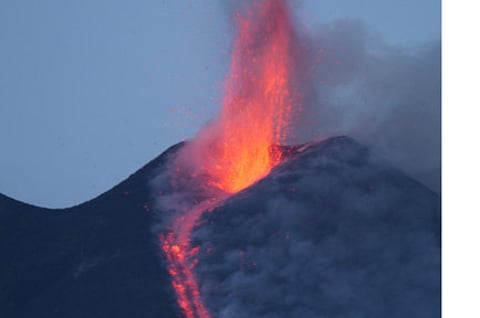Mount Etna’s fiery lure
Tourists queue to take cable cars up Sicily’s fiery mountain, blithely risking lava bombs

Sicily, Italy
The best view of Mount Etna is from the deity of the ancient Greek amphitheatre in Taormina. From here it looms over this coastal town, famous for its pistachios and hosting the G7 summit, swallowing up the landscape. The snow stripes the sides, even in early summer. Smoke plumes rise up. It looks almost fake. At nearby Fanaberia Gelateria, though, they say that to them the volcano is always alive.
Etna, the largest volcano in Europe, is also its most lively. Sitting on the eastern coast of Sicily, covering 1,188sqkm and comprising rocks, woodland and farmland, it erupts all the time, letting off steam with gay abandon, or “burping”, laughs Giuseppe, our tour guide, attempting to make the noise. Since destroying part of the port of Catania in 1669, Etna’s had a good run of low-key eruptions, although it returned to the press in March following an eruption that left 10 people injured when lava mixed with snow, spewing out boiling rocks from a crater on the south-eastern side.
It erupts several times a year. The last one, three days before we arrive, means we cannot travel above 2,500m. The drive up from Zafferana (historic, functioning) or Nicolosi (smaller, quainter) is looping, but an excellent way to view the changing land: it starts with woodland and small shepherd refuges. Then come the broom trees with their yellow, jasmine-scented flowers and butterflies. Vineyards follow, then everything goes black, save the lichen. Lava craters dot the landscape.
The Sapienza refuge acts as a base camp, and looks like a small ski resort. A wooden cafe serving panini also sells postcards of the lava flow that flattened the previous cafe that stood on the very same spot. “The volcano erupts, the lava comes, and it just destroys everything very, very slowly and they have to start again,” explains Giuseppe, who takes tourists up most days. Why do they keep opening shops? He shrugs. “There is a lot of money to be made.”
It’s the start of summer and soon Etna’s cable cars will rival Venetian vaporetti. Today it’s Americans, Canadians and a group of German cyclists up here with us.
Below, huge black rocks and small green bushes, known as mother-in-law’s cushion because of the spikes, line the incline. The clouds are low and the air feels thin. At the summit we are bused to a crater and allowed to wander freely, within reason. There are guards barking in orange padded jackets as we march along trails of hard, still-warm lava, which we chip off and steal.
‘Natural route’
Volcano tourism, says renowned volcanologist Clive Oppenheimer, is “a natural consequence of an active volcano”, and a type of geotourism — new grammar for holidays with a focus on conserving and promoting a sense of “place”.
Another example is Cornwall’s tin mines, which are also filling up, he says, but volcanoes have the monopoly — an estimated 100 million people visit volcanic sites worldwide each year. You can see the appeal. At 3,350m high, Etna looks like a burnt moonscape. The isexcellent, too. But there are drawbacks. Globally, injuries and deaths at volcanoes are on the increase, driven by the rise in popularity of these holidays. Granted, Etna isn’t too dangerous but it’s not without risk.
Sicilians respond to Etna in different ways. Religious locals used to fear it, rushing at the lava with crucifixes. There was a time when they thought Etna was home to a Cyclops blindly throwing lava bombs. During the last few eruptions, families would barbecue meat and fish over the slow-moving lava. They also know that without Etna, Sicilian tourism might struggle, and thanks to the microclimate Etna is the third most important wine-producing area in Italy.
To Guido Alessandro Coffa, who runs Monaci delle Terre Nere hotel just south of Zafferana, Etna is a backdrop. His hotel is one of the closest to the volcano, sitting quietly in its foothills. Coffa, a former engineer, turned this 19th-century millennial-pink monastery into a hotel with a pool. Over the past decade he has bought up various outhouses and turned them into rooms. Floors are made from cocciopesto — brick and lime mortar — and various motifs have been retained.
In the next few years he will restore an amphitheatre and build a spa. But always there is the uncertainty of the next eruption, when the landscape will be shuffled and reshaped. Lava moves at a glacial pace, like squeezed toothpaste down hillsides, swallowing trees, houses, entire villages.
It was here in 1991, during a large eruption, that the Madonna statue is said to have stopped the lava flow. Neapolitans forget that Vesuvius is there, and treat it as an abstract threat, “something from the past”.
In truth, it’s likely to erupt again, with “all that pressure”.
Still, better out than in.
Sign up for the Daily Briefing
Get the latest news and updates straight to your inbox



